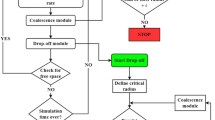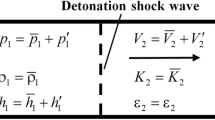Abstract
The condensation happens generally in a nozzle during expansion of compressed steam from convergent to the divergent part of the nozzle. The divergence angle is the angle measured from the throat of the nozzle to the outlet. In this paper, the outlet is kept constant and the throat diameter is varied. In turn, the divergence angle of the sonic nozzle is altered. The effect of divergence angle on condensation phenomena is investigated with wet steam in a sonic nozzle. For analyzing the wet steam properties, the non-equilibrium condensation model is used. This model is the classical nucleation theory coupled with the droplet growth rate equation. The base nozzle is designed with the throat diameter of 4.5 mm and other dimensions are calculated according to ASME nozzle formulas. Furthermore, the chosen divergence angles are 3°, 4.2°, and 6° for which the throat diameters are 4.5 mm, 3 mm, and 1.5 mm, respectively. As the divergence angle is gradually increased, the position of maximum Mach number of the flow moves upstream, the static temperature of the flow near the throat reaches the lower value, and the droplet nucleation rate is increased. The condensation shock gets gradually stronger with decreasing the divergence angle.
Similar content being viewed by others
Abbreviations
- B, C :
-
Virial equation of state coefficients
- C p :
-
Specific heat at constant pressure (J kg−1 K−1)
- C v :
-
Specific heat at constant volume (J kg−1 K−1)
- e :
-
Specific energy (J kg−1)
- h lv :
-
Latent heat of condensation (J kg−1)
- I :
-
Nucleation rate (m−3 s−1)
- k B :
-
Boltzmann constant
- K eff :
-
Effective thermal conductivity (W m−1 K−1)
- M m :
-
Molecular mass (kg mol−1)
- p :
-
Pressure (Pa)
- q c :
-
Evaporation coefficient
- \(\bar r\) :
-
Average radius of droplet (m)
- r * :
-
Kelvin-Helmholtz critical droplet radius (m)
- R :
-
Gas constant (J kg−1 K−1)
- P1 :
-
Inlet pressure
- P3 :
-
Outlet pressure
- S :
-
Supersaturation ratio
- t :
-
Time (s)
- T :
-
Temperature (K)
- T 0 :
-
Temperature of droplet (K)
- T sat :
-
Saturation temperature (K)
- v :
-
Velocity (m s−1)
- α :
-
Divergence angle
- β :
-
Liquid mass fraction
- γ :
-
Specific heat ratio
- Γ :
-
Liquid mass generation rate (kg m−3S−1)
- δ x/h :
-
Length of condensation region (m)
- η :
-
Number of droplets per unit volume (m−3)
- θ :
-
Kantrowitz non-isothermal correction factor
- ρ :
-
Density (kg m−3)
- σ :
-
Liquid surface tension (N m−1)
- τ :
-
Viscous shear stress tensor (Pa)
- g :
-
Saturation phase
- l :
-
Liquid phase
- v :
-
Vapor phase
References
Trigas DM, DATASHEET Sonic Nozzles, https://www.trigasdm.com/files/doc/Sonic-Nozzle-Brochure.pdf.
H. Ding, C. Wang and C. Chen, Non-equilibrium condensation of water vapor in sonic nozzle, Applied Thermal Engineering, 71 (2014) 324–334.
H. Ding, C. Wang and C. Chen, Experimental and numerical studies on self-excited periodic oscillation of vapor condensation in a sonic nozzle, Experimental Thermal and Fluid Science, 68(288–299) (2015) 173–182.
H. Ding, C. Wang and C. Chen, Non-equilibrium condensation process of water vapor in moist air expansion through a sonic nozzle, Flow Measurement and Instrumentation, 40(238–246) (2014) 1357–1362.
P. P. Wegener, Nonequilibrium flow with condensation, Acta Mech., 21(1–2) (1975) 65–91.
A. Aschenbrenner, The influence of humidity on the flow rate of air through critical flow nozzles, Proceedings of the International Conference on Flow Measurement, Flomeko (1983) 71–74.
C. L. Britton, R. W. Cazon and K. Kegel, The critical flow function, C, for humid air, ASME Fluids Engineering Division Summer Meet, Washington DC, USA (5309) (1998).
D. G. Stewart, J. T. R. Watson and A. M. Vaidya, The effect of using atmospheric air in critical flow nozzles, Proceedings of the 4th International Symposium on Fluid Flow Measurement, Denver, Colorado, USA (1999) 27–30.
C. H. Li and B. Mickan, The humidity effect on the calibration of discharge coefficient of sonic nozzle by means of pVTt facility, Proceedings of the 8th International Symposium on Fluid Flow Measurement, Colorado, 302 (2012).
J. M. Lim, B. H. Yoon, Y. K. Oh and K. A. Park, The humidity effect on air flow rates in a critical flow venture nozzle, Flow Meas Instrum, 22 (2011) 402–405.
S. Dykas and W. Wróblewski, Single- and two-fluid models for steam condensing flow modeling, Int. J. Multiph. Flow, 37(9) (2011) 1245–1253.
Y. M. Choi, K. A. Park, J. T. Park, H. M. Choi and S. O. Park, Interference effects of three sonic nozzles of different throat diameters in the same meter tube, Flow Measurement and Instrumentation, 10(175–181) (1999) 175–181.
C. Li, P. Cao, H. Zhang and L. Cui, Throat diameter influence on the flow characteristics of a critical Venturi sonic nozzle, Flow Measurement and Instrumentation, 60 (2018) 105–109.
B. Dhandapani and J.-C. Lee, Effect of non-equilibrium condensation of wet steam in the modified sonic nozzle, J. Comput. Fluids Eng., 25 (2018) 111–119.
P. G. Hill, Condensation of water vapour during supersonic expansion in nozzles, J. Fluid Mech., 25(3) (1966) 593–620.
Ansys Fluent, 12.0 Theory Guide, Ansys Inc., 5 (2009).
G. H. Schnerr, Transonic aerodynamics including strong effects from heat addition, Comput. Fluids, 22(2–3) (1993) 103–116.
D. Barschdorff, Verlauf der zustandgroessem und gasdynamische zuammenhaenge der spontanen kondensation reinen Wasserdampfes in Lavalduesen, Forschung im Ingenieurwesen A, 37(5) (1971) 146–157.
Acknowledgments
This work was supported by a Research Grant of Andong National University.
Author information
Authors and Affiliations
Corresponding author
Additional information
Jang-Chang Lee received his B.S. and M.S. degrees in Mechanical Engineering from Chung-Ang University, Korea, in 1989 and 1991, respectively. He then received his Ph.D. degree from R.P.I. in 2000. Dr. Lee is currently a Professor in Department of Mechanical Engineering at Andong National University in Andong, Korea. Dr. Lee’s research interests include Two-phase flows, Aerodynamics, Condensation, and Cavitation dynamics.
Balasubramanian Dhandapani received his B.Tech. degree in Mechatronics Engineering from SRM University, India in 2019. He completed his M.S. degree in Mechanical Engineering at Andong National University, Korea in Febrary 2022. His research interests include Two-phase flows, Non-equilibrium condensation, and Machine learning.
Rights and permissions
About this article
Cite this article
Dhandapani, B., Lee, JC. Study of divergence angle influence for sonic nozzle in non-equilibrium condensation. J Mech Sci Technol 36, 2993–2999 (2022). https://doi.org/10.1007/s12206-022-0531-x
Received:
Revised:
Accepted:
Published:
Issue Date:
DOI: https://doi.org/10.1007/s12206-022-0531-x




